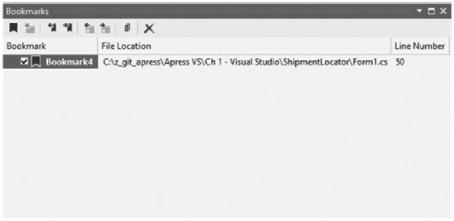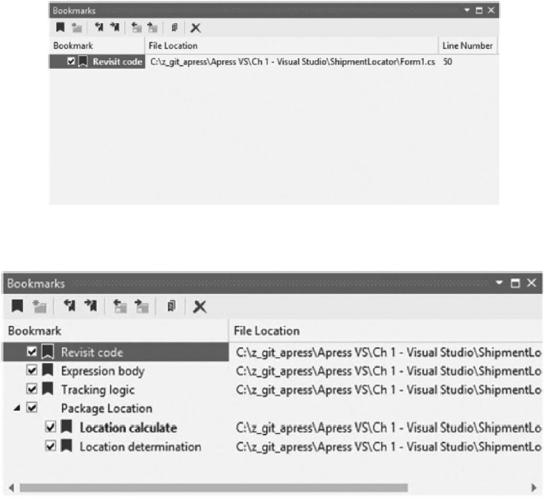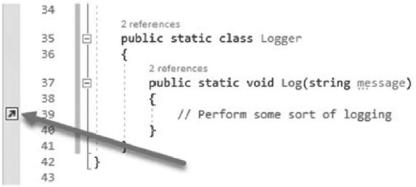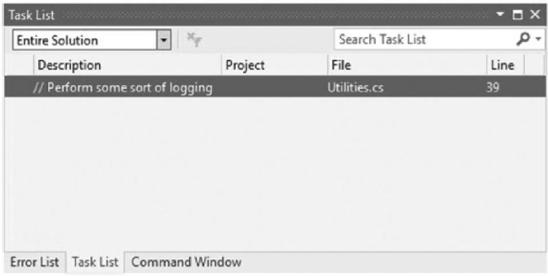
- •Table of Contents
- •About the Author
- •About the Technical Reviewer
- •Acknowledgments
- •Introduction
- •Installing Visual Studio
- •Visual Studio 2022 System Requirements
- •Operating Systems
- •Hardware
- •Supported Languages
- •Additional Notes
- •Visual Studio Is 64-Bit
- •Full .NET 6.0 Support
- •Using Workloads
- •The Solution Explorer
- •Toolbox
- •The Code Editor
- •New Razor Editor
- •What’s Available?
- •Hot Reload
- •Navigating Code
- •Navigate Forward and Backward Commands
- •Navigation Bar
- •Find All References
- •Find Files Faster
- •Reference Highlighting
- •Peek Definition
- •Subword Navigation
- •Features and Productivity Tips
- •Track Active Item in Solution Explorer
- •Hidden Editor Context Menu
- •Open in File Explorer
- •Finding Keyboard Shortcut Mappings
- •Clipboard History
- •Go To Window
- •Navigate to Last Edit Location
- •Multi-caret Editing
- •Sync Namespaces to Match Your Folder Structure
- •Paste JSON As Classes
- •Enable Code Cleanup on Save
- •Add Missing Using on Paste
- •Features in Visual Studio 2022
- •Visual Studio Search
- •Solution Filters
- •Visual Studio IntelliCode
- •Whole Line Completions
- •Visual Studio Live Share
- •Summary
- •Visual Studio Project Types
- •Various Project Templates
- •Console Applications
- •Windows Forms Application
- •Windows Service
- •Web Applications
- •Class Library
- •MAUI
- •Creating a MAUI Application
- •Pairing to Mac for iOS Development
- •Consuming REST Services in MAUI
- •The Complete Weather App
- •The Target Platforms
- •The Required NuGet Package
- •The Weather Models
- •The WeatherService
- •The MainViewModel
- •Registering Dependencies
- •Building the MainPage View
- •Using SQLite in a MAUI Application
- •The ToDoItem Model
- •The ToDoService
- •The MainViewModel
- •Registering Dependencies
- •Building the MainPage View
- •Managing NuGet Packages
- •Using NuGet in Visual Studio
- •Hosting Your Own NuGet Feeds
- •Managing nmp Packages
- •Creating Project Templates
- •Creating and Using Code Snippets
- •Creating Code Snippets
- •Using Bookmarks and Code Shortcuts
- •Bookmarks
- •Code Shortcuts
- •Adding Custom Tokens
- •The Server Explorer
- •Running SQL Queries
- •Visual Studio Windows
- •C# Interactive
- •Code Metrics Results
- •Maintainability Index
- •Cyclomatic Complexity
- •Class Coupling
- •Send Feedback
- •Personalizing Visual Studio
- •Adjust Line Spacing
- •Document Management Customizations
- •The Document Close Button
- •Modify the Dirty Indicator
- •Show Invisible Tabs in Italics in the Tab Drop-Down
- •Colorize Document Tabs
- •Tab Placement
- •Visual Studio Themes
- •Summary
- •Setting a Breakpoint
- •Step into Specific
- •Run to Click
- •Run to Cursor
- •Force Run to Cursor
- •Conditional Breakpoints and Actions
- •Temporary Breakpoints
- •Dependent Breakpoints
- •Dragging Breakpoints
- •Manage Breakpoints with Labels
- •Exporting Breakpoints
- •Using DataTips
- •Visualizing Complex Data Types
- •Bonus Tip
- •Using the Watch Window
- •The DebuggerDisplay Attribute
- •Evaluate Functions Without Side Effects
- •Format Specifiers
- •dynamic
- •hidden
- •results
- •Diagnostic Tools
- •CPU Usage
- •Memory Usage
- •The Events View
- •The Right Tool for the Right Project Type
- •Immediate Window
- •Attaching to a Running Process
- •Attach to a Remote Process
- •Remote Debugger Port Assignments
- •Remote Debugging
- •System Requirements
- •Download and Install Remote Tools
- •Running Remote Tools
- •Start Remote Debugging
- •Summary
- •Creating and Running Unit Tests
- •Create and Run a Test Playlist
- •Testing Timeouts
- •Using Live Unit Tests
- •Using IntelliTest to Generate Unit Tests
- •Focus IntelliTest Code Exploration
- •How to Measure Code Coverage in Visual Studio
- •Summary
- •Create a GitHub Account
- •Create and Clone a Repository
- •Create a Branch from Your Code
- •Creating and Handling Pull Requests
- •Multi-repo Support
- •Compare Branches
- •Check Out Commit
- •Line Staging
- •Summary
- •Index

Chapter 2 Working with Visual Studio 2022
More often than not, you will create your own code snippets based on an existing code snippet. This allows you to reuse functionality you know is working in the existing snippet and include it in your own.
Code snippets are a very powerful productivity feature in Visual Studio.
Using Bookmarks and Code Shortcuts
You will likely be working on an extensive code base at some point in your career. Do this for a while, and you will get bogged down with remembering where a specific bit of code is or where you need to go to get to a specific portion of logic.
Visual Studio can assist developers in bookmarking certain sections of code and add shortcuts to other areas of code. Let’s have a look at what bookmarks and shortcuts are and when to use them.
Bookmarks
Let’s say that you are busy finishing up for the day, but just before you check in your code, you notice that some code doesn’t look right. It is a method with a single return statement, and you know you can use an expression body for methods.
You don’t have the time to play around further because you have already passed the point that you need to leave for home. So in order not to forget to have a closer look at this tomorrow, you decide to bookmark the method.
Place your cursor at the line of code you want to return to, and hold down Ctrl+K, Ctrl+K and Visual Studio will add a bookmark, as seen in Figure 2-53.
Figure 2-53. Bookmark in Visual Studio
The bookmark is added to the side of the code editor and is indicated by a single black bookmark icon.
132

Chapter 2 Working with Visual Studio 2022
To see all the bookmarks in your project, you can hold down Ctrl+K, Ctrl+W or go to the View menu item, select Other Windows, and then click Bookmark window.
The Bookmarks window is displayed as seen in Figure 2-54. From the toolbar in the Bookmarks window, you can group bookmarks in folders, navigate between bookmarks, navigate between bookmarks in the current folder, toggle a bookmark on the currently selected line in code, disable all bookmarks, and delete bookmarks.
Figure 2-54. Bookmarks window
However, another feature not so obvious by looking at this Bookmarks window is the ability to rename bookmarks. To rename a bookmark, click a selected bookmark, and you will see that the name (in this case, “Bookmark4”) becomes editable.
Now you can rename your bookmark to something more relevant to what you need to remember, as seen in Figure 2-55. Go ahead and add some more bookmarks to other random areas of code. Your Bookmarks window will end up looking
full as seen in Figure 2-56.
133

Chapter 2 Working with Visual Studio 2022
Figure 2-55. Renamed bookmark
Figure 2-56. Bookmarks collection
Now click the delete button on the Bookmarks toolbar. The bookmark is deleted without any confirmation from the user.
This is something I can sort of understand. Imagine how irritating it would be having to confirm every delete, especially when you want to remove only a subsection of bookmarks from your collection.
For this reason, I use bookmarks only as a short-term solution to remind me to go and perform some action in code or refactor something I think needs refactoring.
134

Chapter 2 Working with Visual Studio 2022
For me, a bookmark is something I will come back to within the next day or so. Something I don’t want to put off doing. It is, therefore, a temporary placeholder to something I need to revisit.
But what if I wanted to go and add a more permanent pointer to some logic in the code? This is where code shortcuts come in. Let’s have a look at this next.
Code Shortcuts
The ability to add code shortcuts in Visual Studio is more helpful when you need to jump to a certain section of code regularly. To add a shortcut to a specific section of code in Visual Studio, you need to place your cursor on the line of code you need to revisit and press Ctrl+K, Ctrl+H.
Visual Studio will then add the shortcut, as seen in Figure 2-57. To view all the shortcuts added to your project, hold down Ctrl+\, Ctrl+T or go to the View menu, and select Task List to open the Task List window, as seen in Figure 2-58.
Figure 2-57. Code shortcut added indicator
135

Chapter 2 Working with Visual Studio 2022
Figure 2-58. The Task List
In some ways, I prefer the Task List more than bookmarks because I can quickly add items to revisit by adding //TODO: in my code. With your Task List open, go to any place in your code, and add the comment in Listing 2-24.
Listing 2-24. TODO Comment
// TODO: Remember to do something here
Now have a look at your Task List. You will notice that the TODO comment has been added to your Task List, as seen in Figure 2-59.
136

Chapter 2 Working with Visual Studio 2022
Figure 2-59. TODO comments in the Task List
This is a nice and quick method for adding reminders to your code so that you can easily refer to them and navigate to them by double-clicking the item in the Task List. You can, therefore, use the Task List to take you directly to the predefined location in the code.
In Visual Studio, TODO is what we call a predefined token. Therefore, a comment in your code that uses a predefined token will appear in your Task List. The tokenized comment is made up of the following:
•\ |
The comment marker, which is // |
•\ |
The predefined token (TODO in our example) |
•\ |
The rest of the comment |
The code in Listing 2-24 is a valid comment using a token and will appear in the Task List. Visual Studio includes the following default tokens:
•\ HACK
•\ TODO
•\ UNDONE
•\ UnresolvedMergeConflict
137
